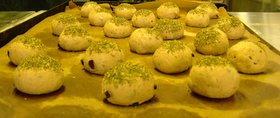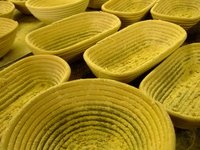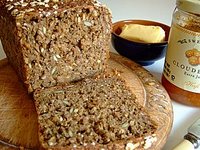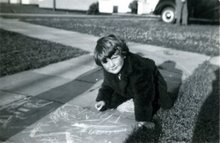
 Troels Bendix (from Denmark) and Kurt Anderson (from Australia), with the assistance of Ross (from Canada), make some of the best bread in London (England). Breadsetcetera has lately opened a café on Clapham High St, just next to Sainsbury’s, which sells bread to the South London cognoscenti as well as breakfast and lunch. Dinner is on the way. On Sunday mornings you can have a full English, decent coffee, and all the newspapers. And you get to make your own toast in your own toaster and choose from a huge array of really good jams and confitures. Just like being at home, without the washing up.
Troels Bendix (from Denmark) and Kurt Anderson (from Australia), with the assistance of Ross (from Canada), make some of the best bread in London (England). Breadsetcetera has lately opened a café on Clapham High St, just next to Sainsbury’s, which sells bread to the South London cognoscenti as well as breakfast and lunch. Dinner is on the way. On Sunday mornings you can have a full English, decent coffee, and all the newspapers. And you get to make your own toast in your own toaster and choose from a huge array of really good jams and confitures. Just like being at home, without the washing up.
The bread is all made on an organic sourdough leaven, or biga. No extra baker's yeast is added. Troels has cared for the biga for five years, starting it off in Wandsworth. He says darkly that it didn’t like the move to Clapham. The biga sits in a big vat, a creamy mixture of organic white, wholemeal and rye flours, with water and the magic Wandsworth wild yeast, now tempered with some local interlopers from Clapham. The scent is just slightly sour, but not pronounced. All the bread in the bakery is raised on this leaven. The yeast bacteria thrive in an anaerobic atmosphere, feeding on the simple sugars they derive from the starch in the flour. The by-product of this activity is carbon dioxide, the gas bubbles which raise the dough.  I spent the day in the bakery just round the corner, with Frida (from Sweden) who manages the café and is also a novice like me. Breadsetcetera makes six different kinds of bread regularly, whole grain rye, original three flours, original white, walnut, six seed and olive, plus muffins and flapjacks and cookies. The recipes for the breads are Troels’ own, and he brings the soul and traditions of Denmark to the rye breads in particular.
I spent the day in the bakery just round the corner, with Frida (from Sweden) who manages the café and is also a novice like me. Breadsetcetera makes six different kinds of bread regularly, whole grain rye, original three flours, original white, walnut, six seed and olive, plus muffins and flapjacks and cookies. The recipes for the breads are Troels’ own, and he brings the soul and traditions of Denmark to the rye breads in particular.
 When we arrived Ross (trained in a Gordon Ramsay kitchen on 18 hour days – now that is a bit of a jaw dropper) had mixed the flours for the recipes and the first dough was curling away in a fifty year old machine. It works slowly and comfortingly and Troels prefers its action to the newer, faster machines. Humming away in the corner it’s like a good friend, solid and dependable. All of the flour is organic and most of it is from Cann Mills, near Shaftesbury in Dorset, milled with a water driven wheel by Michael Stoate.
When we arrived Ross (trained in a Gordon Ramsay kitchen on 18 hour days – now that is a bit of a jaw dropper) had mixed the flours for the recipes and the first dough was curling away in a fifty year old machine. It works slowly and comfortingly and Troels prefers its action to the newer, faster machines. Humming away in the corner it’s like a good friend, solid and dependable. All of the flour is organic and most of it is from Cann Mills, near Shaftesbury in Dorset, milled with a water driven wheel by Michael Stoate.
Salt is added later to the mixture, so as not to inhibit the action of the biga, and some of the dough left over from the previous batch of baking is also added, its sour quality more noticeable after an overnight rest.

The dough comes out of the machine like a duvet coming out of a tumble dryer, and piles in drifts on the stainless steel work surface. It is flowing in its consistency and quite sticky. The proving baskets are generously floured and the dough is cut and weighed. It loses a percentage of its weight through water loss in the baking process, but it must weigh at least the advertised weight – and not too much more because that’s the ‘loss’ in ‘profit and loss’!
Then comes the shaping. Frida and I were completely hopeless at this. An oval loaf is tucked in at the corners and rolled towards you, tucked again and rolled in on itself until it is a tight sausage shape. Round loaves are tucked in and turned a quarter turn, tucked again and turned and then again until the circle is complete; then the dough is flipped over and pushed down and away against the work surface so that the outer skin of the dough tightens into a satiny ball. Frida and I tried. We tried really hard. We were terrible. Every loaf I shaped had to be reshaped by Ross or Troels. I was waiting for the F word and it is a measure of the calming nature of making bread that it never came. But I got good at making rolls, wouldn’t you agree lads?

The dough proves in the coiled cane baskets for about six hours. One of the biggest problems they face in the bakery is the acceleration caused by the heatwave we are in the middle of. They use ice water to mix the dough to retard the proving time. Otherwise tomorrow’s bread is ready yesterday, if you know what I mean.
The proved dough is flipped out of its basket on to a peel, and thence to the oven for twenty five minutes at 250ºC. A fleet of drivers (well, two or three I think!) delivers it fresh to restaurants and shops around London. For the full list see the web site. Most are in the London area, but they are just about to start delivering to Edinburgh!
The café will expand its repertoire presently, with a refit due later in the year and extended opening times. Kurt is planning simple menus favouring tasty produce. Less in the way of sauce and more in the way of source.

If you want to acquire a proving basket you can order a huge variety from the web site. If you are passing the café in Clapham High St drop in for a latte and a chocolate chip cookie and say Hi to Frida and Quentin, and buy a loaf to take home. Try the wholegrain rye – it’s like tasting the entire field.

 Troels Bendix (from
Troels Bendix (from  I spent the day in the bakery just round the corner, with Frida (from
I spent the day in the bakery just round the corner, with Frida (from  When we arrived Ross (trained in a Gordon Ramsay kitchen on 18 hour days – now that is a bit of a jaw dropper) had mixed the flours for the recipes and the first dough was curling away in a fifty year old machine. It works slowly and comfortingly and Troels prefers its action to the newer, faster machines. Humming away in the corner it’s like a good friend, solid and dependable. All of the flour is organic and most of it is from Cann Mills, near Shaftesbury in
When we arrived Ross (trained in a Gordon Ramsay kitchen on 18 hour days – now that is a bit of a jaw dropper) had mixed the flours for the recipes and the first dough was curling away in a fifty year old machine. It works slowly and comfortingly and Troels prefers its action to the newer, faster machines. Humming away in the corner it’s like a good friend, solid and dependable. All of the flour is organic and most of it is from Cann Mills, near Shaftesbury in 





9 comments:
What a great post! This must have been such a fascinating day, and you describe it so well I can smell the dough and bread. I'm horribly envious.
Blimey Lindy that was fast! I was still moving the pictures about and wondering why the font was wandering all over the place! It was a great day, and I now have rather a lot of bread in the house!
Oh my, what wonderful insight! Like Lindy, I'm awfully jealous! I know where I'm going next visit to London.
Do try and visit Bonnie - they are such nice people and you can walk easily from Clapham Common tube station.
Oh, this sounds wonderful, I'm very envious. Sadly, not too many places like that in my area.
Sumisuyoshi
I have found your blog, and I must congratulate you - the bread looks wonderful - and I am impressed by your baking facilities! How fantastic to live in Sicily!
Oh, sorry, I don't live there. Would be nice, but sadly not an option now. That is a link to an acquaintance's blog. I'm trying to make do in the Los Angeles basin. The current temperatures of which are the reason for my exploration of bread on the grill! When it is 100ish degrees F (37c) using the oven becomes a bit unappealing. If I could I'd build a brick oven in the back yard! Again, sorry for the confusion!
Sumisuyoshi
It's also a good way to get a really high temperature I would think - I seem to remember Jeffrey Steingarten doing it when he was trying to bake pizza, and nearly having to call the Fire Brigade! I will definitely have a go.
You can get fairly high temperatures on the baking stone, getting high air temperatures is a bit harder. At least on my grill. It makes it so the bottom crust may burn a bit, and the top never really develops a nice crunchy crust. It takes a bit longer to bake as well. Pizza can work quite well though, and if you do it correctly you don't even need the pizza stone, you can do it straight on the rack which gives kind of a nice smokey flavor.
Post a Comment